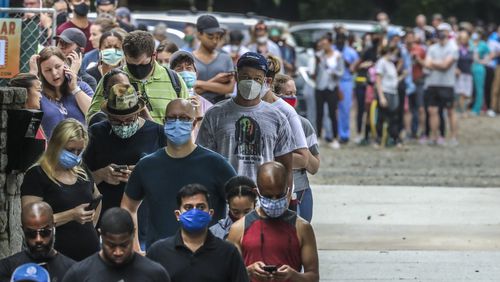On Nov. 3 in Georgia, who is likely to be under the most pressure to leave a long line of voters without casting a ballot? And whose cause might that hurt?
We have all seen the photos from the June 9 primary. But some excellent data-based reporting by ProPublica and Stephen Fowler of Georgia Public Broadcasting has given us hard numbers — and thus firmer answers to both questions.
Since 2013, when the U.S. Supreme Court struck down a critical enforcement mechanism in the Voting Rights Act, Georgia has added 2 million more voters to its rolls, but polling locations have decreased by 10%.
The GPB/ProPublica study focused on nine metro Atlanta counties: Fulton, Gwinnett, Forsyth, DeKalb, Cobb, Hall, Cherokee, Henry and Clayton — all with growing numbers of minority voters. Among the findings:
- These nine counties have nearly half of the state’s active voters, but only 38% of polling places. Since 2012, the average number of 2,600 voters packed into each precinct has grown by nearly 40%, from 2,600 to 3,600. “Georgia law sets a cap of 2,000 voters for a polling place that has experienced significant voter delays, but that limit is rarely if ever enforced,” Fowler writes.
- On June 9, the last day of voting in Republican and Democratic primaries, the average wait time after 7 p.m. was six minutes — if you were at a polling place where at least 90% of voters were white. If you found yourself at a polling station where 90% of voters were Black, the wait time was 51 minutes. That’s an eight-fold difference.
- Six of the seven most congested polling spots in Gwinnett County, Republican-controlled but likely to shift from red to blue on Election Day, are in predominantly nonwhite neighborhoods. Since 2010, the county has added 175,000 voters, but not a single polling location.
- Fulton County added nearly 250,000 voters as it reduced the number of its polling stations. On June 9, two served as poster children for the cameras. Park Tavern in Piedmont Park, an event space, was assigned 16,000 voters when two other polling places were closed because of the pandemic. In Union City, where the number of active voters has increased 60% since 2013, 9,000 voters were assigned to the Christian City Welcome Center. In the June 9 primary, voting there ended in the wee hours of June 10.
So the answers to the above questions are pretty straightforward. Those under the most pressure to abandon their places in line at the polls on Nov. 3 are likely to be voters of color. And given the racial dynamics of Georgia politics, Democrats would bear the brunt of any burden that poses.
Now we get to the far more delicate question of intent.
There can be no doubt that the coronavirus pandemic has made life more complicated for election officials across the state, and for voters trying to navigate between the advice of health authorities (“Mail in your ballot if at all possible, or use a dropbox”) and a president who has done his best to demonize that enterprise.
Further, the push to save or oust Donald Trump now promises to send national turnout to levels unseen since 1908 and the race between William Howard Taft and William Jennings Bryan. The latter was the Trump of his day, but liberal and more familiar with the Bible. (For the younger people in the audience, that’s an allusion to the famous Scopes trial.)
Competence, too, has been a concern in several local election operations. I’m looking at you, Fulton County — although those 300 early voting machines in State Farm Arena was an excellent idea.
There are also many Republicans who point to the surge in new voters — we stand at a record high of nearly 7.4 million registered — as proof that voter suppression can’t possibly be happening in Georgia.
But if you know your state history, you know that surges in minority voting — or the threat of it — are precisely when barriers have been raised in the past. We are more careful in our phrasing now, and the distribution of resources — in election personnel, training, equipment — is often the field of battle.
As mentioned above, the 2,000-voter cap on beleaguered precincts is rarely enforced by the state. And in 2015, then-Secretary of State Brian Kemp’s office sent out a memo to county election offices, offering friendly advice on how to sell reductions in polling places.
“Calculate the number of voting days and number of voters that voted on each day at each location. This should provide the information that clearly shows whether Early Advance in Person Voting allows significantly more people to vote prior to Election Day, thus negating the need for so many polling locations on Election day,” the memo stated. “If you are proposing [fewer] rural locations, might we suggest you show the banks, grocery stores and post office on the map as well. You can create a professional, well-thought-out presentation showing the map, how the change can benefit voters and the public interest.”
The GPB/ProPublica report makes note of Senate Bill 463, a GOP-backed measure introduced in the state Legislature this year that would have required counties to open additional polling stations if voters had to wait more than an hour in the previous election.
Democrats opposed it because no additional funding accompanied the bill’s mandates. While it passed the Senate, SB 463 died in the House when its focus was changed – to bar “the unsolicited distribution of absentee ballot applications” to voters.
I was talking to a state election official recently who spoke of how unfair it was that Democrats heaped blame on Secretary of State Brad Raffensperger, a Republican, for an election system that — in many ways — is controlled by 159 individual counties.
There is some truth in that. More often than not, the fight over voting resources occurs at the county level. Local political culture rules. This is what made Section 5 of the Voting Rights Act, mothballed seven years ago, so effective. It made any change in election law anywhere in Georgia and several other states subject to pre-approval by the U.S. Justice Department.
Many of you might say we’re past all that. I would point you to Sumter County, a majority-Black county and home of President Jimmy Carter. In 2010, voters there — for the first time — elected a majority Black school board.
A month after the election, before the new officers could be sworn in, the lame-duck board changed district lines, added two new at-large members, and shifted future elections from November to May. All to prevent another majority Black board from being elected in the future, according to a federal lawsuit.
A ruling is still being appealed, but for now, a judge has ordered school board elections returned to November. The at-large school board positions will come to an end. Next month, it is entirely possible that Sumter County once again will have a majority Black school board.
Now consider that the same power structure involved in this school board fight might also be in charge of deciding who votes where in Sumter County.








